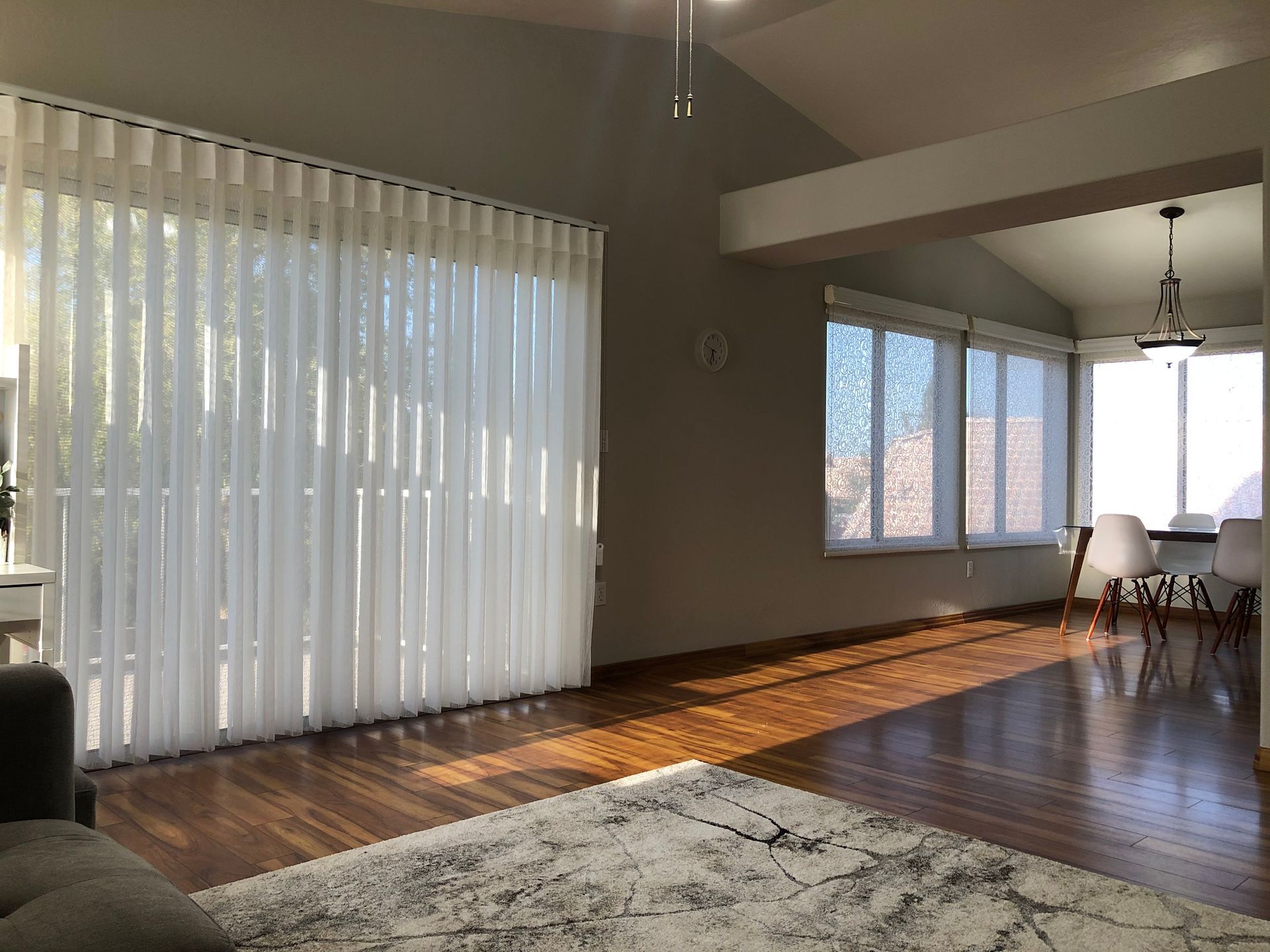Article
Layering Blinds and Curtains
September 6, 2024
The latest modern look: layering blinds and curtains

How to Pair Blinds and Curtains for a Stylish Layered Look
When it comes to window treatments, the choice between blinds and curtains doesn't have to be an either/or decision. In fact, pairing blinds with curtains can create a stylish, layered look that combines the functionality of blinds with the elegance of curtains. This combination offers a unique blend of privacy, light control, and aesthetic appeal, all while elevating the overall design of any room in your home.
In this blog post, we'll explore the benefits of layering blinds and curtains, how to choose the right combination for your space, and tips on executing this look to perfection. By the end, you'll have all the inspiration and practical advice you need to achieve a stylish layered window treatment that enhances both form and function in your home.
Why Layer Blinds and Curtains?
Layering blinds and curtains offers several benefits that can transform the look and feel of your space. Here's why pairing these two types of window treatments is a smart choice:
Enhanced Light Control
Blinds provide precise control over how much light enters a room, allowing you to adjust for glare, brightness, or complete darkness. By pairing blinds with curtains, you add another layer of light control. For example, you can close your blinds to reduce harsh sunlight but leave the curtains open to soften the room with natural light. Alternatively, drawing the curtains can provide an extra layer of darkness for sleeping or watching TV.
Improved Privacy
Blinds are great for maintaining privacy, especially during the day when you want to allow light in but keep prying eyes out. Adding curtains provides an additional layer of privacy, particularly at night when the inside of your home is more visible from outside. The combination of both treatments ensures that your windows are covered at all times while still offering flexibility in how much or little you want to reveal.
Energy Efficiency
Tucson’s desert climate brings intense heat during the summer months and cooler temperatures during the winter. Layering blinds and curtains can help insulate your home and improve energy efficiency. Blinds, especially those made of materials like wood or cellular fabric, help block the sun's heat during the day. Curtains, particularly heavier options, can further reduce heat transfer and keep your home cool. In the winter, the combination of blinds and curtains helps trap heat inside, reducing your reliance on heating systems.
Versatility and Style
Layering window treatments provides endless design possibilities. Whether your home is modern, traditional, or somewhere in between, you can customize the look by pairing different types of blinds and curtains to complement your existing décor. The right combination can add depth, texture, and a sense of sophistication to any room.
Acoustic Benefits
If you live in a noisy area or have rooms that echo, layering blinds and curtains can help reduce noise. Blinds provide a barrier that dampens sound, while curtains made from thick or heavy fabrics further absorb sound, creating a quieter and more serene environment.
Now that we've covered the advantages of layering blinds and curtains, let’s dive into how to select the right combinations for your home.
Choosing the Right Blinds for Your Layered Look
The first step in creating a stylish layered window treatment is selecting the right type of blinds. Each type of blind offers its own unique benefits, so it’s essential to consider factors such as light control, privacy, and design when making your choice.
Here are some popular blind options to consider:
1. Roller Blinds
Roller blinds are simple, sleek, and functional, making them a popular choice for modern homes. They roll up into a compact mechanism at the top of the window, allowing you to adjust the amount of light coming in with ease. Roller blinds are available in various fabrics, from sheer to blackout, giving you control over light and privacy.
Pairing roller blinds with curtains adds a soft, decorative touch to their minimalistic design. For example, you could opt for neutral-colored roller blinds and complement them with bold, patterned curtains to create a balanced look that combines practicality with style.
2. Roman Blinds
Roman blinds are known for their soft, elegant folds that stack evenly when the blind is raised. They bring a classic and sophisticated look to any room while offering excellent light control and privacy. Roman blinds work well in traditional, transitional, and even modern interiors.
When layered with curtains, Roman blinds can create a luxurious, tailored look. Choose Roman blinds in a solid color or subtle pattern and pair them with heavier curtains in complementary colors to achieve a refined, cohesive design.
3. Venetian Blinds
Venetian blinds, made from horizontal slats that can be tilted to control light, are highly versatile and suit a range of interiors. Whether they are made from wood, faux wood, or aluminum, Venetian blinds offer excellent light control and privacy.
Pairing Venetian blinds with curtains creates a dynamic, layered look. The horizontal lines of the blinds contrast nicely with the soft vertical flow of curtains, adding texture and visual interest to the room. To enhance this effect, consider pairing wooden Venetian blinds with lightweight linen curtains for a natural, earthy feel.
4. Cellular (Honeycomb) Blinds
Cellular blinds are designed with honeycomb-shaped cells that trap air, making them one of the most energy-efficient window treatments. These blinds are ideal for homeowners looking to improve insulation and reduce energy costs. Cellular blinds come in a range of opacities, from sheer to blackout, offering various levels of light control and privacy.
When paired with curtains, cellular blinds create a sleek, modern look. Their minimalist design works well with patterned or textured curtains that add personality to the room. This combination is perfect for bedrooms, where insulation, privacy, and light control are key.
5. Zebra Blinds
Zebra blinds, also known as layered or dual roller shades, alternate between solid and sheer stripes, allowing for precise control over light and privacy. These blinds are modern, stylish, and versatile, making them a popular choice for contemporary homes.
Pair zebra blinds with curtains to create a layered look that offers both functionality and elegance. For example, you can use sheer curtains to soften the sharp lines of zebra blinds or go bold with floor-length blackout curtains for a dramatic effect.
Choosing the Right Curtains for Your Layered Look
Once you've selected the blinds, the next step is choosing the perfect curtains to complement them. When layering blinds and curtains, it's important to strike a balance between the two, ensuring that they work together harmoniously.
Here are some key factors to consider when choosing curtains:
1. Fabric
The fabric of your curtains plays a significant role in determining the overall look and feel of the room. Lighter fabrics like linen, cotton, or sheer materials create an airy, relaxed atmosphere, while heavier fabrics like velvet, silk, or thick cotton provide a more formal and luxurious feel.
For a balanced look, pair lightweight blinds (like roller or cellular blinds) with heavier curtains to add depth and texture. Alternatively, if your blinds are more substantial (such as wooden Venetian blinds), consider pairing them with light, flowing curtains to keep the room feeling open and inviting.
2. Color and Pattern
When selecting curtains to layer with blinds, consider how the colors and patterns will interact with the rest of the room. Solid-colored blinds can be paired with patterned curtains for a bold statement, or you can keep things simple by choosing neutral curtains that blend seamlessly with the blinds.
If your room already features bold patterns or colors in its décor, opt for more subdued curtains to avoid overwhelming the space. On the other hand, if your room is relatively neutral, patterned curtains can add a pop of personality and interest.
3. Length and Style
Curtains come in various lengths, from those that skim the window sill to floor-length options that create a dramatic effect. Floor-length curtains are ideal for creating a layered look, as they add a sense of grandeur and help elongate the room’s height.
Additionally, the style of the curtain plays a role in the overall aesthetic. Pencil pleat curtains have a more formal appearance, while eyelet or tab-top curtains are more casual and contemporary. Consider the style of your blinds and room when choosing the curtain design to ensure the two treatments complement each other.
Tips for Layering Blinds and Curtains
Now that you have a better understanding of the types of blinds and curtains available, let’s look at some tips to ensure your layered window treatment looks stylish and cohesive.
1. Consider Functionality
While aesthetics are important, it's crucial not to overlook the practical aspects of your window treatments. Think about the purpose of the room and how you need the blinds and curtains to function. In bedrooms, for example, blackout blinds paired with heavy curtains can create a dark, restful environment. In living rooms, light-filtering blinds combined with sheer curtains can provide a soft, ambient glow while maintaining privacy.
2. Play with Contrasts
To create visual interest, consider playing with contrasting colors, textures, and materials. For example, pairing sleek aluminum blinds with soft, flowing curtains can create a striking contrast that adds depth and character to the room. Similarly, wooden blinds paired with velvet curtains create a rich, layered look that's both sophisticated and warm.
3. Match Hardware
The hardware you use to install your blinds and curtains can also contribute to the overall look. Choose curtain rods, finials, and blind mounts that complement each other in terms of finish and style. For a cohesive look, consider using matching metals or similar tones in the hardware.
4. Layer for Flexibility
One of the greatest benefits of layering blinds and curtains is the flexibility it offers. You can adjust both treatments independently to achieve the perfect balance of light, privacy, and temperature control. For instance, keep the blinds partially open while drawing the curtains to create a soft, diffused light effect. Or, close both the blinds and curtains for complete privacy and maximum light blockage. This flexibility allows you to customize the atmosphere of the room based on the time of day, weather, or activity, making it one of the most versatile approaches to window treatments.
5. Coordinate with the Room’s Decor
Your layered window treatments should complement the room’s overall decor. When pairing blinds and curtains, consider how they interact with your furniture, wall color, flooring, and other decorative elements. For example, if your room has a minimalist design, opt for clean lines and neutral tones in both your blinds and curtains. In a more traditional or eclectic space, don’t be afraid to mix patterns and textures for a bolder look.
6. Install Curtains Slightly Higher
One trick to making your windows look taller and your room feel more spacious is to install your curtain rod slightly higher than the window frame. This technique draws the eye upward, creating the illusion of height. Pairing this with blinds mounted inside the window frame will result in a streamlined, elegant appearance that enhances the room’s proportions.
Examples of Stylish Blinds and Curtains Combinations
To give you a better idea of how to combine blinds and curtains for a stylish layered look, here are a few examples that demonstrate how these two treatments can work together to create a functional and beautiful space.
Example 1: Modern Minimalism with Roller Blinds and Sheer Curtains
For a clean, modern look, pair simple white roller blinds with floor-length sheer curtains in a soft gray or beige. The roller blinds provide excellent light control and privacy, while the sheer curtains add an airy, ethereal feel. This combination works well in rooms with neutral color schemes and minimalist decor, creating a serene and uncluttered space.
Example 2: Traditional Elegance with Roman Blinds and Velvet Curtains
In a more traditional or formal living room or bedroom, consider pairing classic Roman blinds with heavy velvet curtains. Choose Roman blinds in a neutral shade like cream or taupe and complement them with rich, jewel-toned curtains in deep blue, emerald, or burgundy. The Roman blinds provide light control and privacy, while the velvet curtains add a touch of luxury and warmth to the room.
Example 3: Coastal Style with Wooden Venetian Blinds and Linen Curtains
For a relaxed, coastal-inspired look, pair natural wooden Venetian blinds with lightweight linen curtains. The natural texture of the wood complements the breezy feel of linen, creating a calming, earthy atmosphere. This combination works particularly well in rooms with lots of natural light and neutral color palettes, evoking a sense of tranquility and coastal charm.
Example 4: Energy Efficiency with Cellular Blinds and Blackout Curtains
If energy efficiency and light control are your top priorities, consider pairing cellular (honeycomb) blinds with blackout curtains. Cellular blinds are excellent at insulating your home, while blackout curtains ensure complete darkness when needed. This combination is ideal for bedrooms, media rooms, or any space where temperature control and light blockage are essential. Opt for neutral-toned cellular blinds and bold, patterned blackout curtains to add a touch of personality to the room.
Conclusion
Layering blinds and curtains is an excellent way to elevate your window treatments, combining the practical benefits of both with the added style and versatility that each offers. By choosing the right combination of blinds and curtains, you can create a dynamic, visually appealing look that enhances your home’s decor while providing superior light control, privacy, and energy efficiency.
Whether you're aiming for a sleek, modern aesthetic or a more traditional, cozy feel, there are countless ways to pair blinds and curtains for a stylish layered look. Experiment with different materials, colors, and textures to find the perfect match for your space, and remember that functionality and aesthetics should work hand-in-hand to create a window treatment that not only looks great but also meets your practical needs.
If you're ready to upgrade your windows with a layered treatment, StyloHome Blinds, Shades, and More
can help guide you through the process. With a wide selection of blinds and curtains in a variety of styles, materials, and colors, we can help you find the perfect combination to enhance your home’s beauty and functionality. Contact us today to schedule a consultation or explore our collection online.






